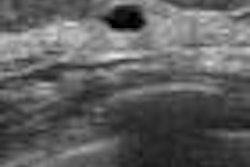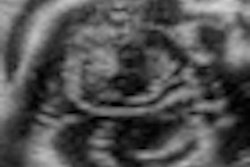VIENNA - Menopause has an important influence on breast elasticity as measured by elasticity parameters, according to study results presented this week at ECR 2013. Taking this factor into consideration may help improve the diagnostic performance of breast sonoelastography, the researchers found.
Much research has been conducted on breast density and elasticity, but menopause as a factor has not been addressed. Due to the decrease of estrogen during menopause, the elasticity of the breast also changes.
In the current study, routine ultrasound and elastographic ultrasound were conducted preoperatively on 286 patients (192 premenopausal and 108 postmenopausal women) using a EUB 7500 system (Hitachi Medical Systems). All told, there were 300 breast lesions, according to Dr. Xiaochong Wang, from the department of ultrasound at Huashan Hospital in Shanghai, and colleagues.
Wang and colleagues focused on strain ratio (SR): SR1 was calculated using the same-level and normal-appearing breast region, while SR2 was calculated using the subcutaneous fat as a reference. The pathologic diagnosis served as the gold standard. The sensitivity, specificity, and area under the curve were evaluated by receiver operator characteristics (ROC) analysis with or without the influence of menopause as a factor.
Histopathology revealed 180 malignant and 120 benign lesions. Without considering menopause, SR1 and SR2 showed moderate diagnostic performance (area under the curve, 0.803 versus 0.782). When the modified SR1 cutoff points of 2.35 and 2.52 were used in the groups of premenopausal and postmenopausal women, respectively, the sensitivity, specificity, and accuracy shot up (79.2%, 92%, and 85.7% versus 64.2%, 81.4%, and 77.3%).
No statistical differences were found in the diagnostic value of SR2 with or without the influence of menopause as a factor: sensitivity, specificity, and accuracy were 59.2%, 77.8%, and 70.3% versus 70%, 73.9%, and 72.7%.
The information presented at ECR is part of Wang's ongoing research from the past two years. Dividing the women into pre- and postmenopausal groups helps improve the detection of lesions, she said. In previous research, she and her colleagues didn't divide the women into the two groups, and the SR1 and SR2 values were not useful.
The biggest limitation of the study is the definition of menopause, Wang said.
"There were many patients in the perimenopause period," she said. "So in my study I defined patients for a session of menopause more than one year."
Some of her patients had breast cancer, which necessitated neoadjuvant chemotherapy, and they weren't menstruating.
"How to define these kinds of patients?" she asked. "I think this is a very serious problem for me."
Wang also cited the need for a larger sample size.



















